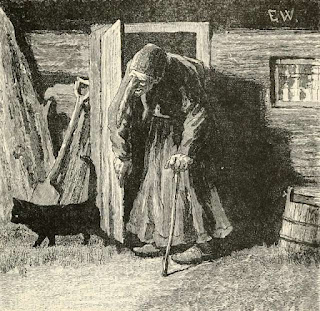Erik Werenskiold, painter and illustrator with emphasis on folklore
Erik Theodor Fredriksen Werenskiold (1855 - 1938) was an important painter and illustrator from Norway. His legacy roughly lies in two groups of artworks: landscapes of the Norwegian countryside and drawings of fantastic creatures like trolls and witches from tales and legends of Norway folklore.
Like most painters of his generation Erik Werenskiold started learning the skills of drawing and painting in his country but soon moved to advance into one or (in his case) both artistic centers in the world - he spent four years in Munich and about six in Paris (with breaks, mostly because of his health issues).
Of course, he also traveled to Italy (Rome and Florence) which was almost mandatory for a learning painter in the 19th century. New trends in painting, like impressionism and experiments with colors or compositions, didn't affect him as much as some of his contemporaries.
His paintings of peasants in landscapes and dozens of portraits of more or less important people of his time earned him enough popularity to get a commission he would love to get from his times in Munich - illustrations of Norwegian Folktales (by Peter Christen Asbjornsen and Jorgen Engebretsen Moe). In this monumental project, he collaborated with Theodor Severin Kittelsen and Otto Ludvig Sindig.
Soria Maria's Castle (fairy tale from Norway Folktales) by Erik Wernskiold
Here are a few additional interesting facts about his life:
- He was born as the fourth son of the commander of Kongsvinger Fortress on the South Norwegian border with Sweden. Thanks to his special achievements in art, although he never participated in the army, Erik Werenskiold got numerous highly valued orders. He became a Knight, Commander, Commander of 1st class, and finally an owner of the Grand Cross of the Royal Norwegian Order of St. Olav. He was awarded the title of Commander of the Order of the Dannebrog as well. And there was another important achievement: in 1908 received a Norwegian national artist's salary.
- His favorite motif was the girl leaning on the fence with the blue sky over the green landscape in the background. Erik Wernskiold painted several versions with one or more girls. Their black dresses with brown belts, and regional (Telemark, Norway) costumes from the 19th century became so famous they are now among national symbols. They are called beltestakk. Such a painting perfectly summarizes the essence of Werenskiold's paintings - romantic realism, which can be also noticed in the more 'serious' (not fairy-tale-inspired) postcards, calendars, and other ephemera.
- Erik married painter Sophie Marie Stoltenberg Thomesen, daughter of politician Thomes Thomesen, and had two sons who became successful in their professions as well: Werner Werenskiold was a geologist and Dagfin Werenskiold was a sculptor.


Comments
Post a Comment